ASUS Zenbook Prime (UX21A) Review: The First of the 2nd Gen Ultrabooks
by Anand Lal Shimpi on May 22, 2012 2:46 PM EST- Posted in
- Laptops
- CPUs
- Asus
- Ivy Bridge
- Zenbook
- Zenbook Prime
- Ultrabook
- Notebooks
The Display in Numbers
The new 1080p panel looks good, but does it make any sacrifices in its performance? Thankfully, no. Max brightness is down a bit compared to the previous generation, but it's still higher than any of the portable Macs and much higher than your typical PC displays. Black levels are much improved over the original Zenbook as well:
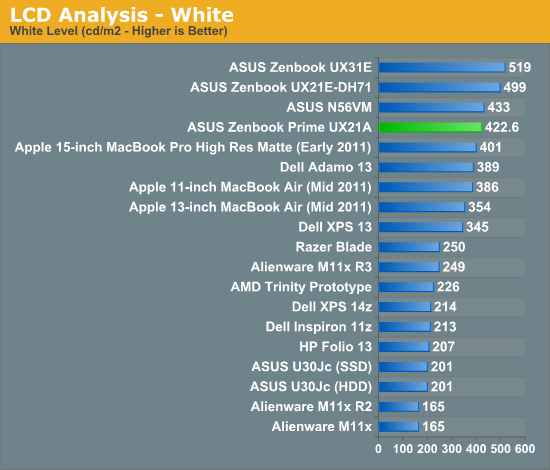
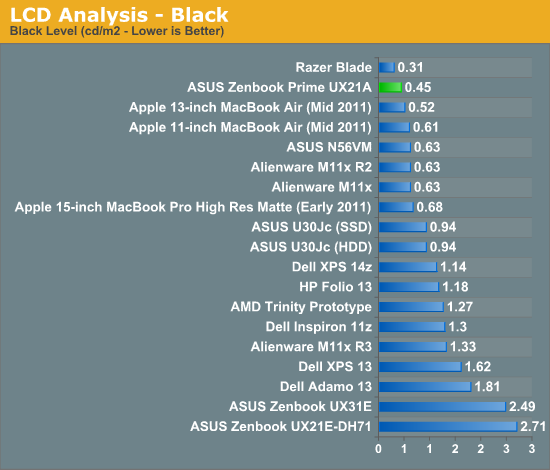
The resulting contrast ratio is almost tablet-like:
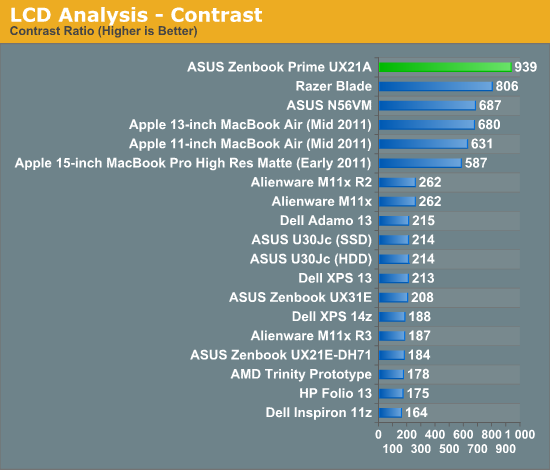
It's not just the basics that ASUS delivers well on, color accuracy is top notch:
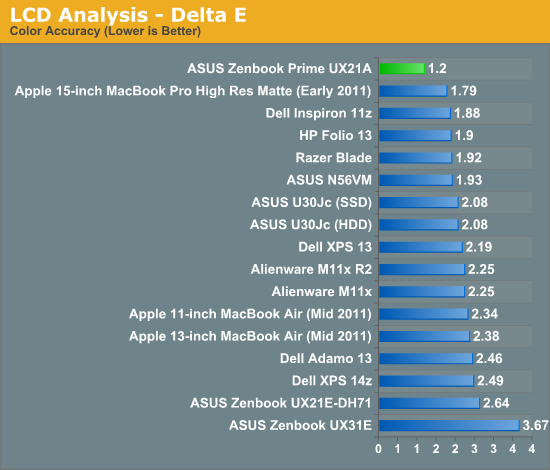
Color gamut is shy of the MacBook Pro but much better than the previous Zenbook and the MacBook Air:
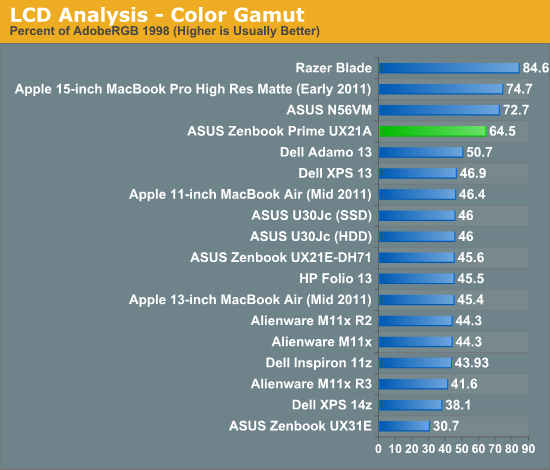
Size is definitely an issue here. While I think the 1920 x 1080 panel will be a very good fit for the 13.3-inch UX31, there's a smaller subset of folks who are going to appreciate it in the 11.6-inch UX21. Personally I think it's fine but at 189 PPI the 11-inch Zenbook Prime is going to be a tough sell for those who have a tough time looking at small text.
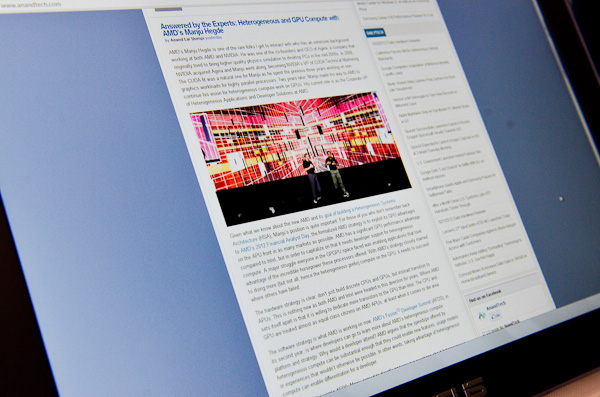
Text on the 11-inch 1080p panel
ASUS' solution is to ship the UX21 with Windows set to 125% DPI scaling by default, unfortunately most applications (including many of Microsoft's own) don't deal with non-integer DPI scaling very well.
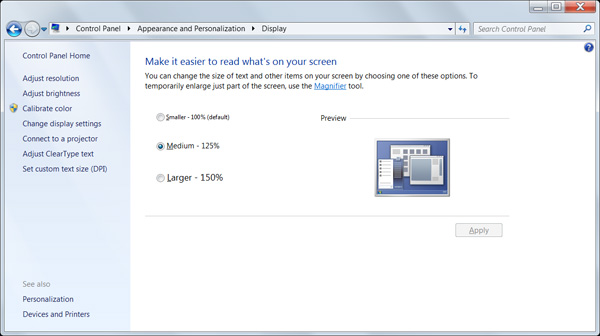
Here's what the default desktop looks like at 125%:
And here are examples of applications that don't behave well with Windows 7's DPI scaling:
In Skype, some text elements are tiny while others are huge. PCMark Vantage is an example of where you see this as well:
Here the scaled text actually can't fit in the area allocated for it, while the rest of the text is entirely too small.
There's not much you can do to work around this today with Windows 7. You're either going to have really small text or have to deal with funny scaling. This is unfortunately a major downside to not controlling the OS layer, ASUS is at the mercy of Microsoft to get scaling for displays with high pixel densities right. Windows 8 should be better in this regard but I ran out of time to try it out on the Zenbook Prime before the embargo lift.




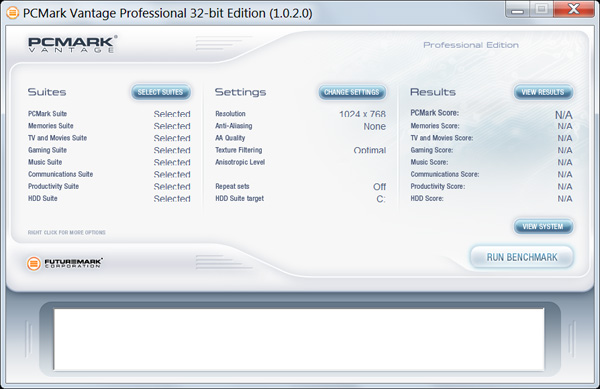








192 Comments
View All Comments
Paedric - Tuesday, May 22, 2012 - link
I don't know for virtual machines, but games are already barely playable even with reduced resolution.This is not a gaming system or workstation you know, this is web surf/ Facebook/other lightweight applications system; adding more RAM is basically useless and will only reduce battery life.
Judging by your comment, this is not the form factor you need, we're not there yet for gaming performance in a 11" ultrabook.
nortexoid - Tuesday, May 22, 2012 - link
Actually more RAM will in most cases improve battery life and performance since it can greatly reduce disk swapping. Fortunately the Zenbook has an SSD so performance won't suffer much from swapping, but if you have just a few apps open ( browser, Word, music player, etc.) that 4GB will go FAST.Manufacturers really need to start moving to 6GB default or else 2/4GB onboard plus a vacant DIMM slot.
puppies - Wednesday, May 23, 2012 - link
Rubbish rubbish rubbish. I have 4gb on my XPS 17, i've had 1GB dedicated to a minecraft server, had music playing, multiple office documents open, and multiple browser pages up and never even got close to maxing my RAM.I can only presume you don't understand how windows grabs way more RAM than it needs (2GBish) and releases it if another program requires it otherwise you are talking about having 20 doccuments and 20 web pages open while attempting to play a resource intensive game at the same time which would turn that low power enveloped CPU into a stuttering mess way before it touched the last 25% of the RAM.
Spathi - Wednesday, May 23, 2012 - link
He speaks the truth nortexoid,I have 16g in my desktop and it uses 12G and I imagine windows would use 6g of 8g and 3g of 4g. Mostly useless caching.
Memory actually uses lots of power (relative to the notebooks current use), so you don't really want to add more.
IMHO, this nb is designed as a gift/recommendation to your gf/wife/mother/aunty/dad. It is the sort of thing you can get them and steal on the holidays when bored, but won't be tempted to steal every day.
It would probably play enough fun games OK, just not the latest at high res. So also good for work/uni without getting carried away gaming. Most of the "latest" candy games are boring anyway after an hour, lol.
ImSpartacus - Wednesday, May 23, 2012 - link
That's not always true. I'm rolling with 8GB of RAM in my Win7 laptop and I've never seen the system use more than half of it. I'm usually around 2GB with Chrome (5-15 tabs), Word and PowerPoint open.Admittedly, my use case is light. However, that is "just a few apps open," yet 4GB has not gone "FAST".
Lucian Armasu - Tuesday, May 22, 2012 - link
Do you really think you're going to need more than 4GB of RAM with the type of GPU's ultrabooks are having?nortexoid - Tuesday, May 22, 2012 - link
Yes, if you don't want to quit all your open apps just to play a game.Sunburn74 - Tuesday, May 22, 2012 - link
Gaming isn't a major feature of this laptop. Its more of a happenstance.The power hit from the extra ram affects use when not gaming. The extra ram is only really useful for a few specific situations (situations which the laptop is not particularly designed for anyway).
seapeople - Saturday, May 26, 2012 - link
You realize that Windows has something called the Page File, right? And that this computer (and most ultrabooks) have a solid state drive?bhima - Wednesday, May 23, 2012 - link
For Graphic Designers on the go, this could be a pretty great machine with that nice monitor but 4GB of ram IS limiting when you are working with 3 adobe programs open and large, 300dpi files.